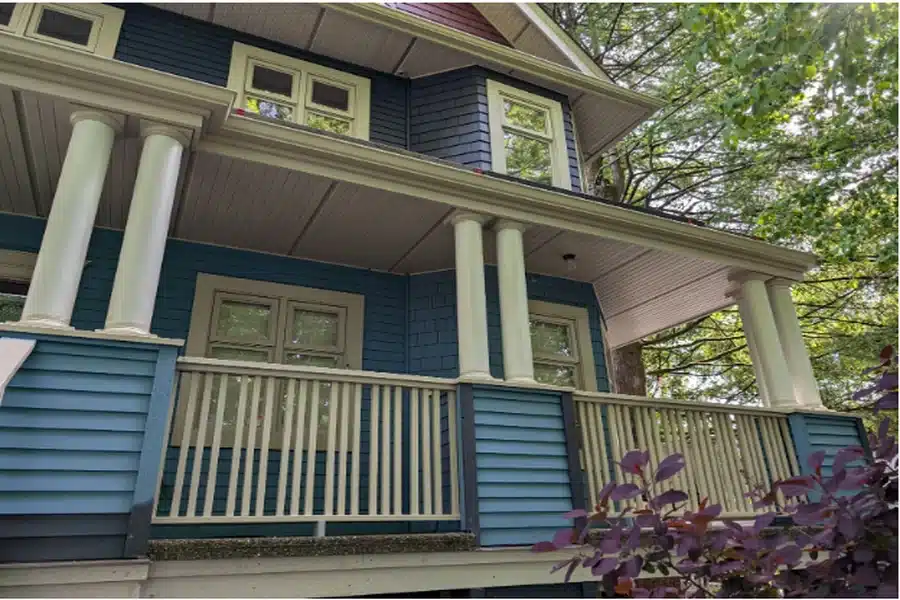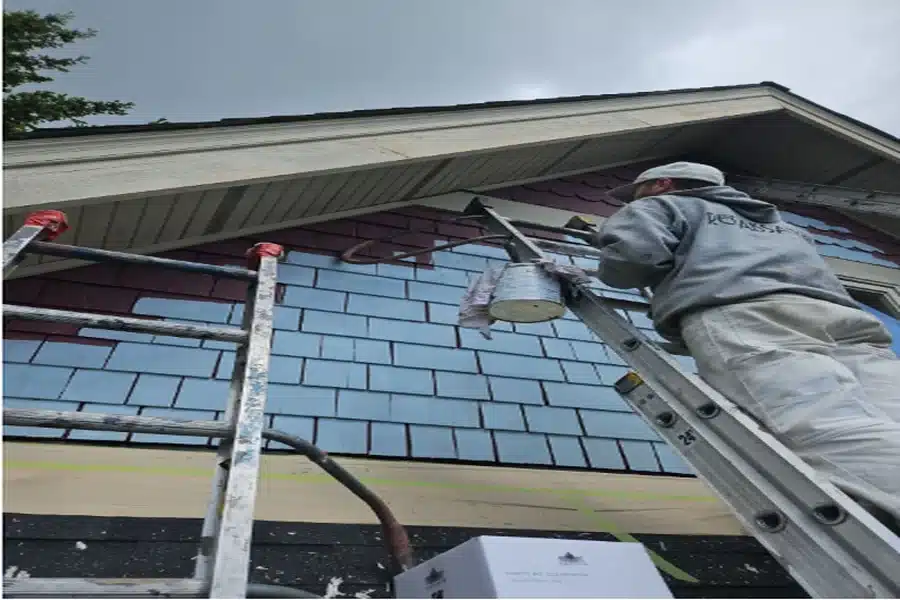The True Cost of Exterior Painting in Vancouver: A Homeowner’s Guide

Standing on your front porch during another typical Vancouver drizzle, you notice the damage. The relentless moisture has taken its toll on your home’s exterior. The once-vibrant paint now appears dull and patchy. These are telltale signs of our coastal climate’s persistent challenge.
Whether you’re dealing with weathered cedar siding or tired stucco, the question inevitably arises. What will it actually cost to restore your home’s protective barrier and curb appeal?
The answer isn’t straightforward. Vancouver’s unique climate conditions create a complex pricing environment. Our diverse architectural landscape adds another layer of complexity. Varying quality standards catch many homeowners off guard. Understanding these nuances can mean the difference between a paint job that lasts two decades and one that starts failing within a few short years.
Real-World Pricing: What Vancouver Homeowners Actually Pay

I’ve spoken with dozens of local contractors recently. I’ve also analyzed recent project completions across the Lower Mainland. Certain patterns emerge in exterior painting service costs. The reality is stark. Most homeowners find themselves investing more than they initially budgeted.
The main culprit? They underestimate the preparation work required in our challenging climate.
- Smaller homes tell one story. Think cozy East Vancouver character houses. Consider compact Burnaby ranchers under 1,500 square feet. Expect to invest between $3,500 and $6,000. These projects typically involve straightforward preparation. They work with relatively newer surfaces. Well-maintained siding requires minimal repair work.
- Most Vancouver homeowners own mid-range properties. These are 2,000 to 2,500 square feet of exterior surface. They require moderate preparation and repair. These projects consistently range from $8,000 to $15,000. The final cost depends heavily on the home’s current condition. Architectural complexity plays a major role.
- Then there are the substantial undertakings. Multi-storey heritage homes in Kitsilano fall into this category. Complex West Vancouver properties with intricate trim work do too. Homes that have been neglected for years also qualify. These projects often exceed $25,000. The cost climbs particularly high when specialized paints become necessary. Extensive restoration work drives prices up further.
The per-square-foot calculation provides a helpful baseline. Most reputable contractors charge between $2 and $6 per square foot of paintable surface. However, this metric alone can be misleading. It doesn’t account for the substantial variables that define each project’s true scope.
The Hidden Factors That Drive Costs
Every estimate tells a story. In Vancouver, that story often involves more complexity than homeowners initially recognize. The most significant cost driver isn’t the paint itself. It’s everything that happens before the first brush stroke.
Surface preparation becomes particularly intensive in our climate. Years of moisture penetration create unique challenges. Wood rot appears in unexpected places. Paint adhesion failures require complete stripping. Our humidity levels demand specialized primers.
A painter might quote preparation work at 40% of the total project cost. They often discover that percentage climbing to 60%. This happens once they begin uncovering the true condition of your home’s exterior.
The type of surface matters enormously. Original cedar siding on heritage homes demands careful attention to grain patterns. Natural oils require special consideration. Stucco surfaces are popular in many Vancouver neighborhoods. They require different techniques. They often reveal cracks that need professional repair.
Newer composite materials might seem easier to work with. They often require specific primer systems to ensure proper adhesion.
Height and accessibility create their own cost pressures. Vancouver’s architectural diversity means many homes feature complex rooflines. Dormers are common. Multi-level designs are frequent. These require specialized equipment. Scaffolding rental alone can add $2,000 to $4,000 to a project. Steep slopes create additional challenges. Limited property access can double labor time for certain sections.
Paint quality represents perhaps the most crucial long-term decision. In our coastal environment, inferior paint products fail dramatically. The difference between a $60-per-gallon premium paint and a $30 contractor-grade option becomes starkly apparent. This becomes evident after three years of Vancouver weather.
Premium paints don’t just look better initially. They maintain their protective properties through countless wet-dry cycles. Their color integrity survives our challenging climate.
Understanding the Professional Landscape
Vancouver’s painting industry reflects the city’s broader service economy. You’ll find everything from weekend warriors offering rock-bottom prices to established companies with decades of local experience. Premium pricing often matches premium service.
The budget tier gets advertised at surprisingly low per-square-foot rates. It typically involves minimal surface preparation. Single-coat application is standard. Basic paint products are the norm. These services might deliver acceptable results on newer homes in excellent condition. They rarely address the underlying issues that cause premature paint failure in our climate.
Here’s the thing about Vancouver’s painting contractors. Most of the solid, established guys fall into what I call the “Goldilocks zone.” They’re not the cheapest. They’re not the most expensive. They’re just right for most homeowners. These are the contractors who’ve been around long enough to know our weather patterns inside and out. They understand why your west-facing wall always fails first. They know which primers actually work on 50-year-old cedar siding.
Then you’ve got the premium outfits. These folks take painting seriously. Maybe too seriously, if you ask me. They’ll spend half a day just analyzing your surfaces before they even talk about paint. They use products that cost more per gallon than some people spend on groceries. But here’s the kicker – sometimes they’re worth every penny. If your house is falling apart or you’ve got some crazy architectural nightmare, these are your people.
Want to know how confident a painter is? Look at their warranty. The weekend warriors offer six months if you’re lucky. Decent contractors back their work for five to seven years. The premium guys? Ten years or more. That’s putting your money where your mouth is.
Why Vancouver Makes Painters Swear
I’ve worked with painters from Alberta and California. They come here thinking they know what they’re doing. Our climate humbles them fast. It’s not just the rain, though God knows we get enough of that. It’s the combination. Moisture that never really goes away. UV that’s stronger than you’d expect. Temperature swings that make paint expand and contract like an accordion.
The painting season here is brutally short. Late May to early September. That’s it. July and August are prime time. Everyone wants their house painted then. Smart homeowners book in February for August jobs. I’ve seen contractors turn down work because they’re booked solid.
Try to paint in October? Good luck. Your painter will be watching the weather forecast like a hawk. One unexpected rainstorm can ruin weeks of work. Delays pile up. Costs multiply. Nobody wins.
Here’s something most people don’t think about. The city actually cares about your paint job. Vancouver’s maintenance bylaws mean peeling paint isn’t just ugly – it’s technically a code violation. Heritage properties get extra scrutiny. Those character homes in Kitsilano? The city expects them to look the part.
And let’s talk about those character homes for a minute. Beautiful houses. Nightmare to paint. All that intricate millwork. Multiple trim colors. Detailed brackets and corbels. It’s like painting a Victorian dollhouse, except the dollhouse is three stories tall and costs half a million dollars. No wonder these jobs command premium prices.
The Math That Matters
So you get three quotes. One for $8,000. One for $15,000. One for $20,000. Same house. Same scope. What gives?
Stop thinking about the upfront cost. Start thinking about the long game. That $15,000 paint job? If it lasts 15 years, you’re paying $1,000 a year for protection. The $8,000 job that needs major touch-ups at year four and a complete redo at year seven? You’re actually paying more in the long run. Plus the hassle. Plus the disruption. Plus the fact that your house looks shabby for years.
Here’s the real kicker. A freshly painted house in Vancouver’s market can add $15,000 to $20,000 in value. Sometimes more. Buyers see a well-maintained exterior and assume the rest of the house is cared for. They see peeling paint and assume the worst. Fair or not, that’s reality.
The decision becomes even clearer when considering Vancouver’s competitive real estate market. A home with a fresh, professionally executed paint job can command a premium of $10,000 to $20,000 in resale value. Properties showing exterior neglect often struggle to attract serious buyers.
Conclusion: Investing Wisely in Your Home’s Future
Painting your Vancouver home’s exterior represents more than routine maintenance. It’s a strategic investment in your property’s long-term health and value. While the upfront costs might seem substantial, understanding the true scope of quality work helps justify the investment.
The most successful homeowners approach exterior painting as a long-term protection strategy rather than a cosmetic update. They recognize that Vancouver’s unique climate demands premium materials and expert application. They budget accordingly. Most importantly, they understand that cutting corners on preparation or materials inevitably leads to premature failure and higher long-term costs.
Whether you’re dealing with a modest character home or a substantial West Side property, the principles remain consistent. Thorough preparation is essential. Quality materials matter. Skilled application is crucial. Realistic expectations about our coastal climate’s demands are necessary.
Approached thoughtfully, exterior painting becomes not just an expense, but a wise investment in your home’s future.
